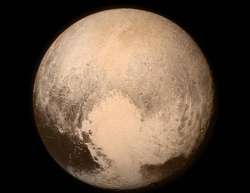Pluto could have subsurface ocean that still holds alien life, suggest fresh clues obtained by NASA
Washington: Fresh clues obtained by NASA’s New Horizons reveal that dwarf planet Pluto in the Kuiper belt, which is believed to have once had a liquid ocean on its surface, may still have liquid water

Washington: Fresh clues obtained by NASA’s New Horizons reveal that dwarf planet Pluto in the Kuiper belt, which is believed to have once had a liquid ocean on its surface, may still have liquid water present beneath its icy crust.
The findings were revealed through Nasa's New Horizons probe that flew close to Pluto last year.
The latest findings suggest the ocean could still hold liquid water beneath its surface, raising hopes that signs of life could still be possible.
According to the British physicist Brian Cox, there are possibilities that the Pluto could yet support life under its outer crust with temperature underwater oceans.
A number of geographical research claims that Pluto’s oceans have frozen millions or billions of years ago and it could have caused the entire planet to shrivel.
But according to the new pictures by New Horizons, Pluto has undergone a global expansion possibly due to the slow freezing of a subsurface ocean.
Pictures of Pluto show an exotic surface which scientists say is made up of different types of ices- water, nitrogen and methane.
“[The New Horizons probe] showed you that there may well be a subsurface ocean on Pluto, which means — if our understanding of life on Earth is even slightly correct — that you could have living things there,” Cox told a leading daily.
Researchers were surprised after a detailed study on the geographical details gleaned from New Horizons and discovered that the flowing ice and epic ice mountains standing as high as 3,500 metres.
According to Alan Stern, principal investigator of the New Horizons mission, “The bedrock that makes those mountains must be made of H2O, water ice.”
“We see water ice on Pluto for the first time. We can be very sure that the water is there in great abundance”, shortly after the probe made its flyby.
NASA is still receiving the data from its probe and there is still much more to go and study about the dwarf planet.
But for now it’s impossible to know about the temperature of Pluto’s water environments as there are lot of factors left to study.